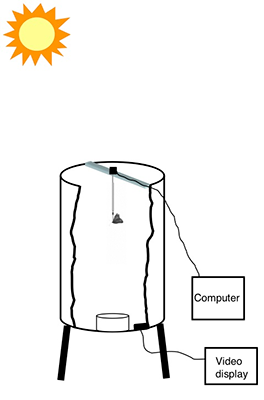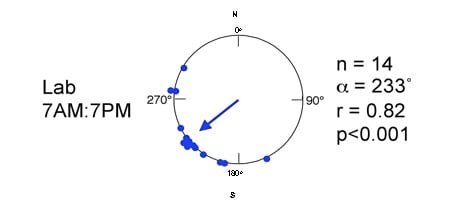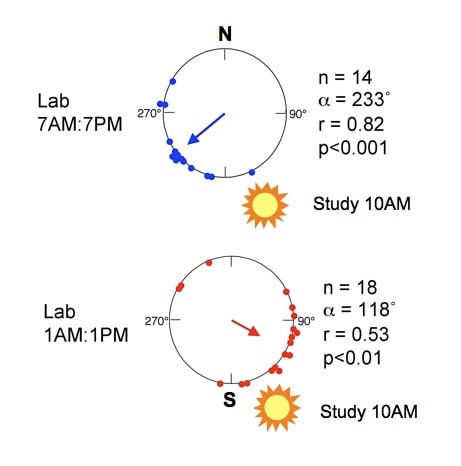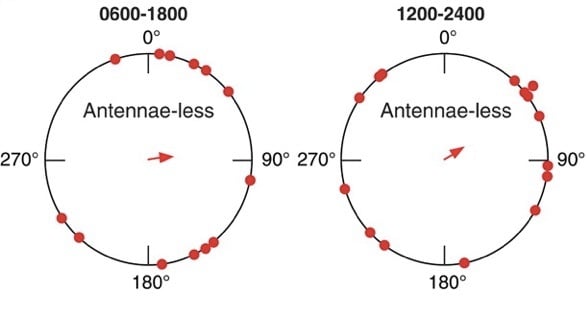Flight Simulator
 To investigate the orientation behavior of migrating monarchs, we use a monarch flight simulator that is a modified version (Reppert et al., 2004) of the one first described by Henrik Mouritsen and Barrie Frost (Mouritsen and Frost, 2002).
To investigate the orientation behavior of migrating monarchs, we use a monarch flight simulator that is a modified version (Reppert et al., 2004) of the one first described by Henrik Mouritsen and Barrie Frost (Mouritsen and Frost, 2002).
An individual monarch butterfly is affixed to a directional recording device using a short length of wire. It may flap its wings and rotate freely, but cannot move vertically or horizontally. The tethered butterfly is suspended in a plastic barrel, excluding buildings, trees, and mountains from view. A fan blows air at the monarch from below, mimicking a thermal. During flight, a video recorder monitors the butterfly and the directional recording device sends orientation information to a computer.
This video depicts a tethered monarch in the flight simulator, recorded from above. Even when the butterfly is manually rotated to a new direction (as in this video), it quickly corrects its bearing to continue on a migratory path.

The above histogram summarizes orientation data for a single migrant butterfly in the flight simulator over 15 minutes. The vast majority of recordings (taken every 200 milliseconds) captured a southwesterly flight bearing.

Froy et al. Science 300: 1303-1305 (2003)
The above graph plots orientation data from 14 different migrant butterflies. Each butterfly’s average compass bearing is represented by a blue dot on the circle. As a group, the butterflies oriented to the southwest on average.
We can see that under normal conditions, migrating monarchs orient to the southwest in order to reach their destination overwintering sites in Mexico. But what role does the circadian clock play in this behavior?
To find out, we asked what would happen if we confused the clock. The butterflies in the above graph were housed under normal light/dark conditions in the lab, with simulated sunup at 7 AM and simulated sundown at 7PM. Another group of butterflies we clock-shifted by 6 hours, with simulated sunup at 1 AM and simulated sundown at 1 PM. So when tested in the flight simulator at 10 AM, the normal butterflies perceived it to be 10 AM while the clock-shifted butterflies perceived it to be 4 PM.

Froy et al. Science 300: 1303-1305 (2003)
In the morning, the sun is in the southeast. So to fly southwest at 10 AM, a monarch must steer to the right of the sun. As we’ve seen already, the normal monarchs did just that (above, top). In the afternoon, the sun is in the southwest. So to fly southwest at 4 PM—the time the clock-shifted butterflies perceived it to be—a monarch must steer towards the sun. Indeed, the clock-shifted monarchs did just that. But because it was actually 10 AM, this meant the clock-shifted monarchs oriented to the southeast (above, bottom).
In other words, shifting the clock by 6 hours (a quarter of a day) shifted the monarchs’ bearing by 90 degrees (a quarter of a compass).

Merlin et al. Science 325: 1700-1704 (2009)
Just as shifting the clock shifts the monarchs’ bearing, breaking the clock completely abolishes any time-compensated orientation. Monarchs without antennae, which house the circadian clock that governs sun compass orientation, exhibit directionless flight in the simulator regardless of their light/dark schedule (above).